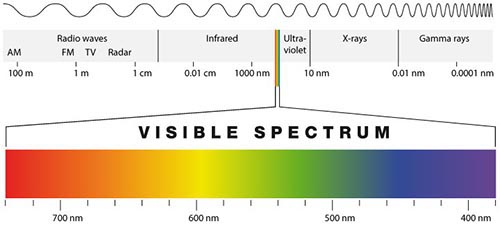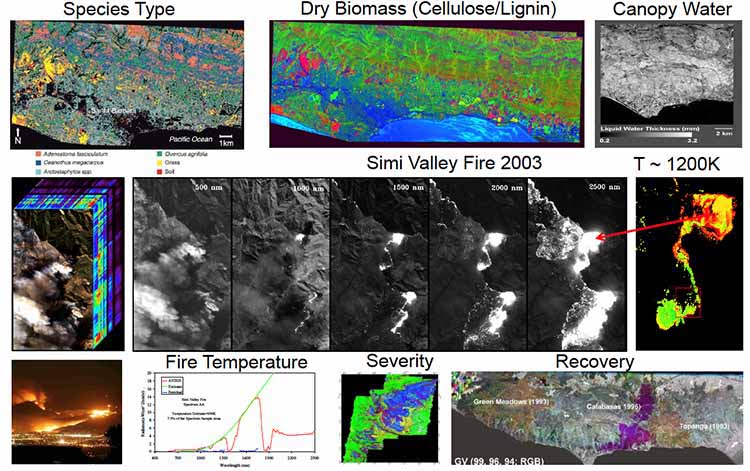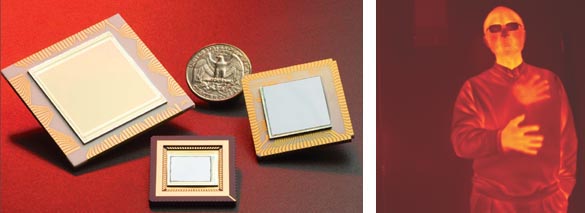NASA's Jet Propulsion Laboratory in Pasadena, California is the winner of the 2018 Herschel Award for its important contributions to infrared device technology, in particular for its central role in developing the High Operating Temperature Barrier InfraRed Detector (HOT BIRD). If you have never heard of the Herschel Award, do not feel bad -- presented by the Military Sensing Symposia (MSS) Committee, it is narrowly focused on the advancement of the infrared technology and sensing domains. Receiving the Herschel Award is a timely endorsement of JPL's leadership position in high-performance infrared detection.
Which Came First, the HOT BIRD or the Egg?

Detectors like HOT BIRD are devices designed to uncover phenomena of interest. They are essential for converting electromagnetic radiation into a usable signal for pursuing science objectives. The truth is, we have all got built-in detectors: our eyes, ears, noses, even our skin. But can you imagine being able to walk into a lab and manufacture an organ as miraculous as the human eye? That is more or less what is happening in the field of infrared sensor technology. Theorists and developers are imagining and then finding ways to create tiny, complex structures with components that humans cannot see with their naked eyes -- building them one atomic layer at a time.
Using carefully chosen elements and alloys of elements, atoms are deposited onto a special substrate material and coaxed into orderly rows, then 'grown' into three-dimensional crystalline structures called superlattices. After more processing, these artificially created lattices are assembled into the devices we call focal plane arrays. The final product is only 5 to 10 microns thick, which is about the width of spider web silk or a droplet of fog. Almost every aspect of the process can be customized, or tuned, to achieve specific results or measure a particular material.
How Hot is HOT BIRD?

Creating IR detectors is an incredibly tricky process that requires powerful machines, state-of-the-art nano-fabrication tools, and a high degree of skill, which, not surprisingly, also makes it a very expensive undertaking. Not only that, but in order to get precise results, the array must be operated at very low temperatures, which requires extensive cryo-cooling. That is why lowering the manufacturing costs and raising the operating temperatures is highly desirable.
Mercury Cadmium Telluride (HgCdTe), or MCT, is a common infrared photodetector material. It has tremendous flexibility over a wide range of the IR spectrum. The main drawbacks of MCT are that it is soft and brittle and requires extreme care in growth, fabrication, and storage. Consequently, it can be quite costly. Over the past two decades much effort has gone into the search for lower cost alternatives. Indium antimonide (InSb) is an alternative, despite requiring much lower operating temperatures. InSb does not have an adjustable cutoff wavelength like MCT, but is used because the robustness of the material means that InSb detectors can be much more cost-effective to make.
HOT BIRD combines the higher operating temperature characteristics of MCT with the material robustness manufacturing advantages of InSb. "A versatile and reliable technology like HOT BIRD expands the options for scientists and researchers, allowing them to choose the best tool for the desired application," says David Ting, a Senior Research Scientist at the Jet Propulsion Laboratory, who originated the concept. In addition, like MCT, the HOT BIRD offers continuous cutoff wavelength adjustability like MCT, enabling its use for multiple applications.
This BIRD Doesn't Fly…Yet

New to space and flight applications, the possibilities for NASA uses of HOT BIRD are even now being conceived. HOT BIRD represents a unique and successful collaboration between JPL and a non-NASA sponsor. JPL plans on leveraging the benefits of HOT BIRD for the mutual interest of NASA and industry, as well as the U.S. government. Garnering the attention and support of the MSS with the Herschel Award reinforces the fact that JPL's work is a key national asset.
Scientists are actively engaged in developing both long- and very long-wavelength Earth and planetary imaging applications supported by the NASA ROSES, ACT and PICASSO programs. Potential uses and opportunities for study include NASA flight projects as well as airborne, balloon, ground based, and in situ instruments in many areas, such as:
- Fire detection
- Seeing where flames are active despite haze or smoke
- Identifying dangerous hot spots that are not visible to the eye
- Imaging land forms -- anywhere (Earth, the Moon, other planets)
- Material detection, identification, and measurement
- Monitoring geologic processes, in situ resources
- Monitoring agriculture crops for moisture, nitrogen, chlorophyll, sugars -- i.e., are the crops healthy and growing as desired?
- Finding snow and ice
- Atmospheric sounding
- Mapping contamination and hazards (Superfund sites, oil spills, methane leaks)
- Ecosystem composition and modeling (measuring ozone, CO2, H2O, etc.)
- Enhanced weather detection and prediction (ocean surface temperatures and other related NOAA applications)
- Atmospheric correction -- the ability to see through dust, clouds, haze, etc. Important for safely landing aircraft or helicopters
- Detecting the presence of electromagnetic radiation (EMR), gravitational fields, magnetic fields, seismic waves, acoustic waves, and other phenomena
- Addressing key science questions related to habitability, related to the above topics
We're Visual Creatures

High resolution photos of Saturn's rings, the surface of Mars, or the swirling storms on Jupiter are undeniably impressive. But they do not always provide actionable information that could enable real-world decision making. With the help of technology enabled by HOT BIRD, we could begin to peel back the surface layers, 'see' more, and collect more useful data. HOT BIRD could deliver high-risk, high-payoff technology for NASA's planetary, astrophysics, and Earth science missions. This bird is ready to fly!
Acknowledgements
JPL Engineering Fellow and Supervisor of the Infrared Photonics Technology Group, Sarath Gunapala, accepted the Herschel Award on behalf of JPL at the 2018 MSS meeting, held March 19-22 in Gaithersburg, Maryland. JPL Senior Research Scientist David Ting, who originated the HOT BIRD concept and led its development, was quick to point out that the HOT BIRD was made possible by state-of-the-art facilities at the JPL Microdevices Laboratory and the talented and dedicated team of researchers that Sarath Gunapala assembled together over the past two decades. Other HOT BIRD team members (both past and present) include Alexander Soibel, Arezou Khoshakhlagh, Linda Höglund, Sam Keo, Sir Rafol, Cory Hill, Anita Fisher, Edward Luong, John K. Liu, Jason Mumolo, and Brian Pepper.